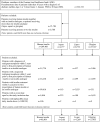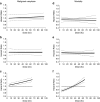Risk of malignancies in patients with diabetes treated with human insulin or insulin analogues: a cohort study
- PMID: 19565214
- PMCID: PMC2723679
- DOI: 10.1007/s00125-009-1418-4
Risk of malignancies in patients with diabetes treated with human insulin or insulin analogues: a cohort study
Abstract
Aims/hypothesis: The aim of this cohort study was to investigate the risk of malignant neoplasms and mortality in patients with diabetes treated either with human insulin or with one of three insulin analogues.
Methods: Data were provided by the largest German statutory health insurance fund (time-frame: January 1998 to June 2005 inclusive), on patients without known malignant disease who had received first-time therapy for diabetes mellitus exclusively with human insulin, aspart, lispro or glargine. The primary outcome was the diagnosis of a malignant neoplasm. Data were analysed by multiple Cox regression models adjusting for potential confounders.
Results: A total of 127,031 patients were included, with a mean follow-up time of 1.63 (median 1.41, maximum 4.41) years. A positive association between cancer incidence and insulin dose was found for all insulin types. Because patients receiving combined therapy with insulin analogues and human insulin were excluded, the mean daily dose was much lower for glargine than for human insulin, and a slightly lower cancer incidence in the glargine group was found. After adjusting for dose, a dose-dependent increase in cancer risk was found for treatment with glargine compared with human insulin (p < 0.0001): the adjusted HR was 1.09 (95% CI 1.00 to 1.19) for a daily dose of 10 IU, 1.19 (95% CI 1.10 to 1.30) for a daily dose of 30 IU, and 1.31 (95% CI 1.20 to 1.42) for a daily dose of 50 IU. No increased risk was found for aspart (p = 0.30) or lispro (p = 0.96) compared with human insulin.
Conclusions/interpretation: Considering the overall relationship between insulin dose and cancer, and the lower dose with glargine, the cancer incidence with glargine was higher than expected compared with human insulin. Our results based on observational data support safety concerns surrounding the mitogenic properties of glargine in diabetic patients. Prospective long-term studies are needed to further evaluate the safety of insulin analogues, especially glargine.
Figures


Comment in
-
Insulin resistance and increased risk for malignant neoplasms: confounding of the data on insulin glargine.Diabetologia. 2010 Jan;53(1):206-8. doi: 10.1007/s00125-009-1535-0. Epub 2009 Sep 24. Diabetologia. 2010. PMID: 19774358 No abstract available.
-
Risk of malignancies in patients with diabetes treated with human insulin or insulin analogues. Reply to Nagel JM, Mansmann U, Wegscheider K et al. [letter] and Simon D [letter].Diabetologia. 2010 Jan;53(1):209-11. doi: 10.1007/s00125-009-1582-6. Epub 2009 Oct 24. Diabetologia. 2010. PMID: 19855952 No abstract available.
-
Diabetes treatment with insulin glargine and risk of malignancy: methodological pitfalls and ethical issues.Diabetologia. 2010 Jan;53(1):204-5. doi: 10.1007/s00125-009-1572-8. Epub 2009 Oct 27. Diabetologia. 2010. PMID: 19859691 Free PMC article. No abstract available.
-
Dualities of interest are not restricted to financial ties to the pharmaceutical industry.Diabetologia. 2010 Jan;53(1):212-3. doi: 10.1007/s00125-009-1603-5. Epub 2009 Nov 17. Diabetologia. 2010. PMID: 19921143 No abstract available.
References
-
- {'text': '', 'ref_index': 1, 'ids': [{'type': 'PubMed', 'value': '12096082', 'is_inner': True, 'url': 'https://pubmed.ncbi.nlm.nih.gov/12096082/'}]}
- Sandhu MS, Dunger DB, Giovannucci EL (2002) Insulin, insulin-like growth factor-I (IGF-I), IGF binding proteins, their biologic interactions, and colorectal cancer. J Natl Cancer Inst 94:972–980 - PubMed
-
- {'text': '', 'ref_index': 1, 'ids': [{'type': 'PubMed', 'value': '8959325', 'is_inner': True, 'url': 'https://pubmed.ncbi.nlm.nih.gov/8959325/'}]}
- Tran TT, Medline A, Bruce WR (1996) Insulin promotion of colon tumors in rats. Cancer Epidemiol Biomarkers Prev 5:1013–1015 - PubMed
-
- {'text': '', 'ref_index': 1, 'ids': [{'type': 'DOI', 'value': '10.1002/ijc.22717', 'is_inner': False, 'url': 'https://doi.org/10.1002/ijc.22717'}, {'type': 'PubMed', 'value': '17397032', 'is_inner': True, 'url': 'https://pubmed.ncbi.nlm.nih.gov/17397032/'}]}
- Larsson SC, Mantzoros CS, Wolk A (2007) Diabetes mellitus and risk of breast cancer: a meta-analysis. Int J Cancer 121:856–862 - PubMed
-
- {'text': '', 'ref_index': 1, 'ids': [{'type': 'DOI', 'value': '10.1007/s00125-006-0468-0', 'is_inner': False, 'url': 'https://doi.org/10.1007/s00125-006-0468-0'}, {'type': 'PubMed', 'value': '17021919', 'is_inner': True, 'url': 'https://pubmed.ncbi.nlm.nih.gov/17021919/'}]}
- Larsson SC, Orsini N, Brismar K, Wolk A (2006) Diabetes mellitus and risk of bladder cancer: a meta-analysis. Diabetologia 49:2819–2823 - PubMed
-
- {'text': '', 'ref_index': 1, 'ids': [{'type': 'PubMed', 'value': '16288121', 'is_inner': True, 'url': 'https://pubmed.ncbi.nlm.nih.gov/16288121/'}]}
- Larsson SC, Orsini N, Wolk A (2005) Diabetes mellitus and risk of colorectal cancer: a meta-analysis. J Natl Cancer Inst 97:1679–1687 - PubMed
MeSH terms
Substances
LinkOut - more resources
Full Text Sources
Other Literature Sources
Medical

